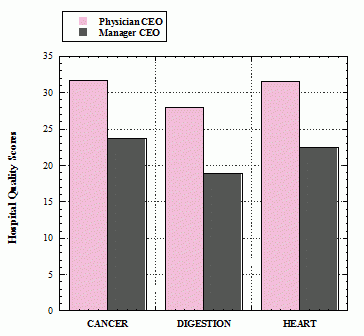In the past, hospitals were routinely led by doctors. That has changed. In the UK and the US, most hospital chief executive officers (CEOs) are non-physician managers rather than physicians (Falcone and Satiani 2008). Of the 6,500 hospitals in the US, only 235 are led by physicians (Gunderman and Kanter 2009).
It has been suggested that placing physicians in leadership positions can result in improved hospital performance and patient care (Horton 2008, Falcone and Satiani 2008, Darzi 2009, Candace and Giordana 2009, Stoller 2009, Dwyer 2010). The UK has recently established five academic health science centres. Their mission is to bring the practice of medicine closer to research – in the hope that innovative science can more quickly be translated into clinical procedures (Smith 2009). Physician leadership was also prioritised in the 2008 National Health Service (NHS) review (Darzi 2008, 2009). Some outstanding US medical facilities – for example the Cleveland and Mayo clinics – have explicitly introduced leadership training (e.g. Stoller et al. 2007), and management and leadership education is being incorporated into medical degrees.
Despite the growing body of research into hospital performance (see Bloom et al. 2010 and Gaynor and Propper 2010 on this site), there are currently no empirical studies that assess the physician-leadership hypothesis that hospitals perform better when they are led by doctors. To establish a clear relationship between leadership and organizational outcomes is challenging. Unlike in medical trials, random assignment – in this case of chief executive officers to hospitals – cannot be used. My research provides an empirical inquiry (Goodall 2011). It looks at the leaders currently being hired by hospitals and examines whether CEOs in hospitals ranked higher typically physicians or non-medical managers.
The wealthiest and most prestigious hospitals arguably have the widest choice of leadership candidates. If it can be shown that hospitals positioned higher in a widely-used media ranking are more likely to be led by medical experts rather than managers, this is one form of evidence that physician-leaders may make effective CEOs.
Studying CEOs of top-ranked US hospitals
The paper identifies the CEOs in the top ranked hospitals in America – determining whether those hospitals situated higher in the league-table are more likely to be headed by physician-leaders or professional managers.To do this, one particular quality ranking is used, namely, the league tables produced by US News and World Report’s “Best Hospitals” 2009. I construct a dataset on CEOs in the top-100 hospitals in the three specialties of cancer, digestive disorders, and heart and heart surgery.
The US News and World Report ranking is designed to inform consumers about where to seek treatments for serious or complex medical problems. Media-generated league tables cannot be viewed as entirely reliable measures of quality; nonetheless, using rating systems as heuristic devices to assess healthcare providers has become common in the US (Schneider and Epstein 1998) and it has been shown to influence consumers’ behaviour (Pope 2009). I use this ranking because it is one of the most established. The data in my study cover the top-100 hospitals in the three specialist fields of cancer, digestive disorders, and heart and heart surgery. Each hospital CEO is then identified and classified into one of two categories – physician-leaders, who have been trained in medicine (MD), and leaders who are non-physician managers.
Physician-led hospitals are higher-quality hospitals
To establish whether hospitals higher in the rankings are more likely to be led by physicians, I use t-tests and regression equations. I do this for the top-100 hospitals in each of the three medical fields of cancer, heart and heart surgery and digestive disorders.
In the field of cancer there are 51 physician-leaders among this set of 100 CEOs. Thirty-three are in the top-50 hospitals, and 18 lead hospitals in the lower 50 group. For the other two specialities, there are, respectively, 34 physician-leaders in the top-100 hospitals in digestive disorders, and 37 in heart and heart surgery. As can be seen in Figure 1, in each of the three cases, the average hospital quality score of hospitals where the chief executive officer is a physician is greater than the score of the hospitals where the CEO is a professional manager.
Figure 1. Average hospital quality score of hospitals led by physician CEOs and manager CEOs in three specialty fields
In the statistical analyses, the regression equations reveal that the presence of a physician-CEO is positively associated with an extra 8 to 9 hospital quality points (at the p<0.001 level) – in short, hospital quality scores are approximately 25% higher in physician-run hospitals than in the average hospital.
To control for the size of hospital, in the field of cancer I included a variable for the number of beds. However, this size variable was insignificant and, importantly, it did not affect the importance of physician-leaders.
Why are better hospitals more likely to be physician-led?
This study’s results are cross-sectional associations and use one particular hospital-quality ranking. This means they have important limitations. The findings do not prove that doctors make more effective leaders than professional managers. Potentially, they may even reveal a form of the reverse – assortative matching – in that the top hospitals may be more likely to seek out MDs as leaders and vice versa. Arguably, however, the better hospitals will have a wider pool of CEO candidates from which to choose, because of the extra status and wealth that they attract. This makes the fact established in this study an interesting one. The results show that hospitals positioned highest in the ranking have made judgements that differ from those hospitals lower down. On average they have chosen to hire physician-leaders as CEOs.
These findings are consistent with my earlier work on the role of “expert leaders” in other (non-medical) settings – for example, presidents of research universities (Goodall 2006 2009a,b) and NBA basketball coaches (Goodall et al. 2011). Cross-sectional analyses can only be suggestive of causality. Nevertheless, it is interesting to consider possible explanations. Experts may have the advantage that they have acquired a deep intuitive knowledge about the core business of their organisations and this may help with decision-making and institutional strategy. Falcone and Satiani (2008) suggest that a physician-leader who has spent years as a medical practitioner has acquired integrity that implies “walking the walk” (2008, p92) which, they argue, enhances a leader’s credibility. Physician-leaders who have greater credibility may act as role models for medical staff and their presence may help hospitals to attract talented medical personnel. However, such explanations are merely suggestive; the mechanisms are not properly understood.
There has been much discussion in the US, and increasingly in the UK, about the relative merits of having physicians and non-physician managers in leadership positions. Yet no evidence has been published one way or the other. This work does not establish that physicians make more effective leaders when compared with professional managers; but it starts the empirical process. It finds – in each of three disciplinary fields – that hospitals positioned higher in the US News and World Report’s “Best Hospitals” ranking are led disproportionately by physicians. The next, and vital, step for researchers is to design longitudinal inquiries into the possibility that physician-leaders improve the performance of American hospitals
References
Bloom, Nicholas, Rebecca Homkes, Rafaella Sadun, and John Van Reenen (2010), “Why good practices really matter in healthcare”, VoxEU.org, 17 December.
Candace, I and RW Giordano (2009), “Doctors as leaders”, British Medical Journal, 338:b1555.
Darzi, A (2008), High quality care for all: NHS next stage review final report,Department of Health, London.
Darzi, A (2009), “A Time for revolutions — The role of physicians in health care reform”, New England Journal of Medicine, 361:e8.
Dwyer, AJ (2010), “Medical managers in contemporary healthcare organisations: a consideration of the literature”, Australian Health Review, 34:514-522.
Falcone, BE and B Satiani (2008), “Physician as hospital chief executive officer”, Vascular and Endovascular Surgery, 42:88-94.
Gaynor, Marty and Carol Propper (2010), “Healthcare competition saves lives”, VoxEU.org, 23 August.
Goodall, AH (2006), “Should research universities be led by top researchers, and are they?”, Journal of Documentation, 62:388-411.
Goodall, AH (2009a), “Highly cited leaders and the performance of research universities”, Research Policy, 38:1079-1092.
Goodall, AH (2009b), Socrates in the boardroom: Why research universities should be led by top scholars, Princeton University Press.
Goodall, AH (2011) “Physician-leaders and hospital performance: Is there an association?”, Social Science and Medicine, forthcoming
Goodall, AH, MK Lawrence, and AJ Oswald (2011), “Why do leaders matter? A study of expert knowledge in a superstar setting”, Journal of Economic Behaviour and Organization, 77:265-284.
Gunderman, R, and SL Kanter (2009), “Educating physicians to lead hospitals”, Academic Medicine, 84:1348-1351.
Horton, R (2008), “The Darzi vision: Quality, engagement, and professionalism”, The Lancet, 372:3-4.
Pope, DG (2009), “Reacting to rankings: Evidence from ‘America's Best Hospitals’”” Journal of Health Economics, 28:1154-1165.
Schneider, EC, and AM Epstein (1998), “Use of public performance reports”, Journal of the American Medical Association, 279:1638-1642.
Smith, SK (2009), “The value of Academic Health Science Centres for UK medicine”, The Lancet, 373:1056-1058.
Stoller, JK, E Berkowitz, and PL Bailin (2007), “Physician management and leadership education at the Cleveland Clinic Foundation: program impact and experience over 14 years”, Journal of Medical Practice Management, 22: 237-42.
US News and World Report (2009) “America’s Best Hospitals” ,methodology and ranking, produced by Research Triangle Institute.



